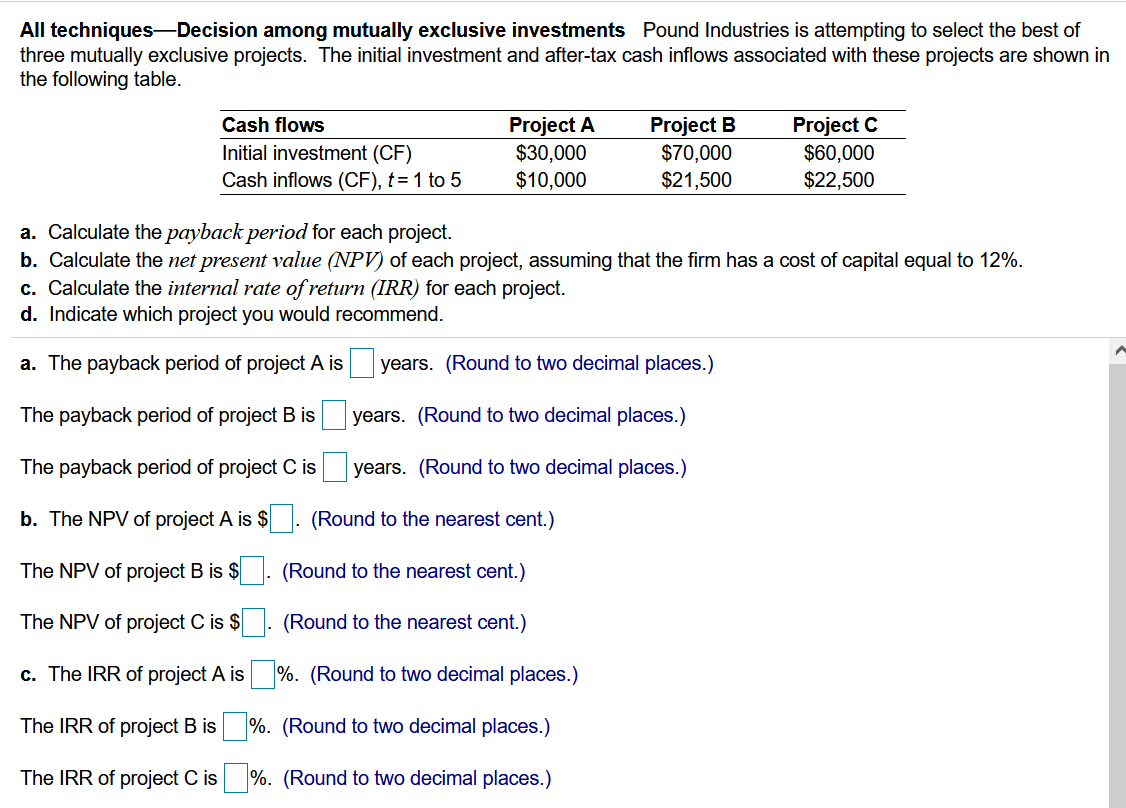All techniques-Decision among mutually exclusive investments Pound Industries is attempting to select the best of three mutually exclusive projects. The initial investment and after-tax cash inflows associated with these projects are show the following table. Project A $30,000 $10,000 Project C $60,000 $22,500 Cash flows Initial investment (CF) Cash inflows (CF), t= 1 to 5 Project B $70,000 $21,500 a. Calculate the payback period for each project. b. Calculate the net present value (NPV) of each project, assuming that the firm has a cost of capital equal to 12%. c. Calculate the internal rate of return (IRR) for each project. d. Indicate which project you would recommend. a. The payback period of project A is years. (Round to two decimal places.) The payback period of project B is years. (Round to two decimal places.) The payback period of project C is years. (Round to two decimal places.) b. The NPV of project A is $ (Round to the nearest cent.) The NPV of project B is $ (Round to the nearest cent.) The NPV of project C is $ (Round to the nearest cent.) c. The IRR of project A is %. (Round to two decimal places.) The IRR of project B is %. (Round to two decimal places.) The IRR of project C is %. (Round to two decimal places.)
All techniques-Decision among mutually exclusive investments Pound Industries is attempting to select the best of three mutually exclusive projects. The initial investment and after-tax cash inflows associated with these projects are show the following table. Project A $30,000 $10,000 Project C $60,000 $22,500 Cash flows Initial investment (CF) Cash inflows (CF), t= 1 to 5 Project B $70,000 $21,500 a. Calculate the payback period for each project. b. Calculate the net present value (NPV) of each project, assuming that the firm has a cost of capital equal to 12%. c. Calculate the internal rate of return (IRR) for each project. d. Indicate which project you would recommend. a. The payback period of project A is years. (Round to two decimal places.) The payback period of project B is years. (Round to two decimal places.) The payback period of project C is years. (Round to two decimal places.) b. The NPV of project A is $ (Round to the nearest cent.) The NPV of project B is $ (Round to the nearest cent.) The NPV of project C is $ (Round to the nearest cent.) c. The IRR of project A is %. (Round to two decimal places.) The IRR of project B is %. (Round to two decimal places.) The IRR of project C is %. (Round to two decimal places.)
Financial And Managerial Accounting
15th Edition
ISBN:9781337902663
Author:WARREN, Carl S.
Publisher:WARREN, Carl S.
Chapter26: Capital Investment Analysis
Section: Chapter Questions
Problem 2CMA: Staten Corporation is considering two mutually exclusive projects. Both require an initial outlay of...
Related questions
Question

Transcribed Image Text:All techniques--Decision among mutually exclusive investments Pound Industries is attempting to select the best of
three mutually exclusive projects. The initial investment and after-tax cash inflows associated with these projects are shown in
the following table.
Project B
$70,000
$21,500
Project C
$60,000
$22,500
Cash flows
Initial investment (CF)
Cash inflows (CF), t= 1 to 5
Project A
$30,000
$10,000
a. Calculate the payback period for each project.
b. Calculate the net present value (NPV) of each project, assuming that the firm has a cost of capital equal to 12%.
c. Calculate the internal rate of return (IRR) for each project.
d. Indicate which project you would recommend.
a. The payback period of project A is
years. (Round to two decimal places.)
The payback period of project B is
years. (Round to two decimal places.)
The payback period of project C is
years. (Round to two decimal places.)
b. The NPV of project A is $. (Round to the nearest cent.)
The NPV of project B is $
(Round to the nearest cent.)
The NPV of project C is $
(Round to the nearest cent.)
c. The IRR of project A is %. (Round to two decimal places.)
The IRR of project B is
%. (Round to two decimal places.)
The IRR of project C is
%. (Round to two decimal places.)
Expert Solution
This question has been solved!
Explore an expertly crafted, step-by-step solution for a thorough understanding of key concepts.
This is a popular solution!
Trending now
This is a popular solution!
Step by step
Solved in 6 steps

Knowledge Booster
Learn more about
Need a deep-dive on the concept behind this application? Look no further. Learn more about this topic, finance and related others by exploring similar questions and additional content below.Recommended textbooks for you

Financial And Managerial Accounting
Accounting
ISBN:
9781337902663
Author:
WARREN, Carl S.
Publisher:
Cengage Learning,

Managerial Accounting
Accounting
ISBN:
9781337912020
Author:
Carl Warren, Ph.d. Cma William B. Tayler
Publisher:
South-Western College Pub

Intermediate Financial Management (MindTap Course…
Finance
ISBN:
9781337395083
Author:
Eugene F. Brigham, Phillip R. Daves
Publisher:
Cengage Learning

Financial And Managerial Accounting
Accounting
ISBN:
9781337902663
Author:
WARREN, Carl S.
Publisher:
Cengage Learning,

Managerial Accounting
Accounting
ISBN:
9781337912020
Author:
Carl Warren, Ph.d. Cma William B. Tayler
Publisher:
South-Western College Pub

Intermediate Financial Management (MindTap Course…
Finance
ISBN:
9781337395083
Author:
Eugene F. Brigham, Phillip R. Daves
Publisher:
Cengage Learning

EBK CONTEMPORARY FINANCIAL MANAGEMENT
Finance
ISBN:
9781337514835
Author:
MOYER
Publisher:
CENGAGE LEARNING - CONSIGNMENT


Survey of Accounting (Accounting I)
Accounting
ISBN:
9781305961883
Author:
Carl Warren
Publisher:
Cengage Learning